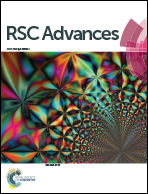Nanohybrids of organo-modified layered double hydroxides and polyurethanes with enhanced mechanical, damping and UV absorption properties†
Abstract
The construction of high-performance polymer–clay nanocomposites plays an important role in developing new types of organic–inorganic hybrids. In this work, a series of polymer–clay nanocomposites were prepared based on polyurethane (PU) and chemical grafting of γ-aminopropyltriethoxysilane (APS) onto dodecyl sulfonate (DS) intercalated MgAl layered double hydroxide (APS–DS–LDH). The detailed morphology, damping properties, mechanical behavior, thermal stability as well as ultraviolet absorption ability of the PU/LDH nanocomposites were studied systematically. Results reveal that the addition of APS grafted DS/LDH nanoparticles can enhance the damping properties and the thermal decomposition temperature, compared with the pristine PU. A mechanical test shows that the flexibility of the nanocomposites is significantly improved by the incorporation of APS–DS–LDH, especially for the LDH content of 3%. Meanwhile, ultraviolet absorption intensity also increases by 33%. It is expected that the PU/APS–DS–LDH nanocomposites can be used as structural damping materials and elastomers in practical applications.


 Please wait while we load your content...
Please wait while we load your content...